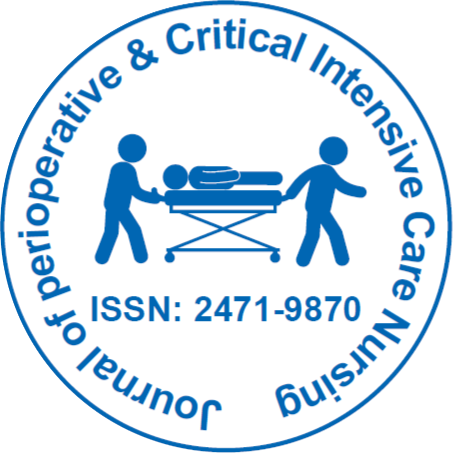
Journal of Perioperative & Critical Intensive Care Nursing
Open Access
ISSN: 2471-9870

ISSN: 2471-9870
Commentary - (2022)Volume 8, Issue 2
The word "pulmonary" refers to topics that concern the lungs. Its root is the "lung" related Latin word “pulmo”. A person who has pulmonary illness likely has a lung issue, which can make it challenging for them to breathe normally. Pulmonary medicine refers to the diagnosis and management of respiratory and pulmonary diseases. Children and teens with breathing or sleeping issues are treated in our renowned pulmonary programme. Children with cystic fibrosis and asthma are treated in clinics that specialize in these conditions. Symptoms that necessitate a comprehensive evaluation include wheezing, chest pain, recurrent pneumonia, coughing, shortness of breath, and trouble exercising. A doctor who specializes in the diagnosis and treatment of diseases of the respiratory system-which includes the lungs and other breathing assist organs, is known as a pulmonologist. When it comes to certain relatively short-term diseases that harm a child's lungs, such the flu or pneumonia, children may be able to receive all of the necessary treatments from their regular doctor. However, you should see a pulmonologist if your cough, shortness of breath, or other symptoms don't go away. If the teenager has a short-term or longterm respiratory condition, the Pulmonary Medicine specialists will treat them with outstanding care and compassion. In addition to being specialists in caring for children and adults with Cystic Fibrosis (CF), from examination through diagnosis and treatment, as well as giving patients access to clinical trials and helping them with symptom management to improve their quality of life and lifespan, they are also experts in diagnosing and treating everything from cough, asthma, and sleep disturbances to more complicated conditions like bronchopulmonary dysplasia, interstitial lung disease, and lung transplantation. Over 65,000 adults and children with lung (pulmonary) and sleep issues are diagnosed and treated annually at the Mayo Clinic's Pulmonary Medicine Division. People with serious and complex medical issues involving the lungs and breathing can get assistance from our specialists in pulmonary, critical care, and sleep medicine. The pulmonology and critical care division is one of the largest, most diverse, all-inclusive, and well-known practices in the world. The organization consists of more than 100 experts in lung disease, sleep disorders, and critical care. Internal medicine known as pulmonary medicine specialists on the diagnosis and care of diseases of the respiratory system, including those that affect the lungs, upper airways, thoracic cavity, and chest wall. Although general internists and other specialists treat the majority of common respiratory issues, pulmonologists-internists who specialize in pulmonary medicineare frequently called upon to assist in the diagnosis of unidentified disorders and the management of challenging, unusual, or complex respiratory diseases.
Pulmonary treatment
Treatment for pulmonary sickness typically involves the employment of a pulmonologist, a physician who specializes in the diagnosis and treatment of lung and breathing illnesses, including lung cancer, chronic obstructive pulmonary disease, and asthma. While bronchoscopy, which enables a medical professional to look into the lungs, is a lung technique that pulmonologists can do, they are not permitted to perform lung surgeries. If surgery is necessary, a cardiothoracic surgeon would often treat pulmonary conditions. Hospitalists, intensivists, and other medical professionals can treat a range of acute illnesses including pulmonary embolisms.
• Emphysema and chronic obstructive bronchitis are two examples of Chronic Obstructive Pulmonary Disease (COPD). Several workplace risks including cigarette smoking are frequent causes.
• The symptoms, which include coughing and shortness of breath, have been prevalent for a while.
• Asbestos and radon exposure, in addition to smoking, can increase the chance of developing lung cancer. Additionally, cancer from other parts of the body can travel to the lungs.
• Pneumonia is an influenza illness or upper respiratory tract infection can infect and irritate the lungs. A viral or bacterial illness may be to blame.
• A blood clot lodged in the main blood vessel that supplies the lungs, the pulmonary artery, or one of its branches results in Pulmonary Embolism (PE). PE often results from a condition called as Deep Vein Thrombosis, in which a blood clot develops in the legs, dislodges, and travels to the blood vessels in the lungs (DVT). Breathing issues, chest pain, and blood in the cough are all signs of PE.
• High blood pressure causes pulmonary hypertension, which weakens the right side of the heart over time by making it work harder.
• Sarcoidosis is a rare disorder in which the lungs and other organs acquire tiny cell clusters (granulomas), limiting their ability to function.
A child who coughs, wheezes, or both is the most typical clinical presentation in paediatric respiratory medicine. Depending on the region, the data gathered from the history and physical examination will carry varying weights in the first diagnostic approach. The most common cause of mortality in youngsters is pneumonia. A child's cough will be assessed first for the possibility of pneumonia in countries where lower respiratory tract infections significantly increase morbidity and death.
The likelihood that a child has pneumonia is increased by fever, tachypnea, retractions, nasal flaring in infants less than one year of age, and a history of poor nutrition. A single clinical outcome cannot, however, be used in isolation as a predictor.
Citation: Kaur A (2022) Impact of Pulmonary Medicine in Children. J Perioper Crit Intensive Care Nurs. 8:198.
Received: 04-Jul-2022, Manuscript No. JPCIC-22-21158; Editor assigned: 06-Jul-2022, Pre QC No. JPCIC-22-21158 (PQ); Reviewed: 21-Jul-2022, QC No. JPCIC-22-21158; Revised: 27-Jul-2022, Manuscript No. JPCIC-22-21158 (R); Published: 04-Aug-2022 , DOI: 10.35248/2471-9870.22.8.198
Copyright: © 2022 Kaur A. This is an open-access article distributed under the terms of the Creative Commons Attribution License, which permits unrestricted use, distribution, and reproduction in any medium, provided the original author and source are credited.